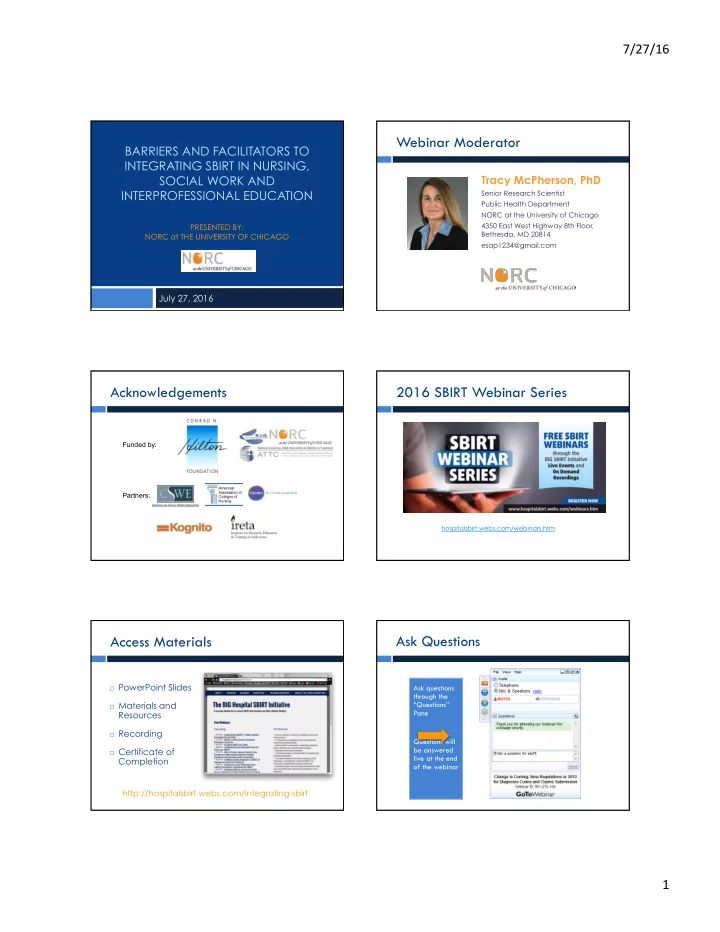

7/27/16 ¡ Webinar Moderator BARRIERS AND FACILITATORS TO INTEGRATING SBIRT IN NURSING, SOCIAL WORK AND Tracy McPherson, PhD INTERPROFESSIONAL EDUCATION Senior Research Scientist Public Health Department NORC at the University of Chicago PRESENTED BY: 4350 East West Highway 8th Floor, Bethesda, MD 20814 NORC at THE UNIVERSITY OF CHICAGO esap1234@gmail.com July 27, 2016 Acknowledgements 2016 SBIRT Webinar Series Funded by: Partners: hospitalsbirt.webs.com/webinars.htm Ask Questions Access Materials ¨ PowerPoint Slides Ask questions through the ¨ Materials and “Questions” Pane Resources ¨ Recording Questions will be answered ¨ Certificate of live at the end Completion of the webinar http://hospitalsbirt.webs.com/integrating-sbirt 1 ¡
7/27/16 ¡ Technical Facilitator Webinar Presenters Hildie Cohen Misti Storie, MS, NCC Survey Director Technical Consultant Health Sciences Department misti.storie@gmail.com NORC at the University of Chicago 55 E Monroe Street, 31st Floor www.mististorie.com Chicago, IL 60603 Cohen-Hildie@norc.org Webinar Presenters Webinar Presenters Danielle Noriega Hannah Joseph Research Analyst Public Health Department Research Analyst NORC at the University of Chicago Public Health Department 55 E Monroe Street, 30th Floor NORC at the University of Chicago Chicago, IL 60603 Joseph-Hannah@norc.org Noriega-Danielle@norc.org Overview ¨ What is SBIRT? Introduction ¨ Overview of the Integrating SBIRT in Nursing and Social Work Education Project (Integrating SBIRT Project) ¨ Barriers and Facilitators to Integrating SBIRT ¨ Overview of Resources ¨ Q & A 2 ¡
7/27/16 ¡ What is SBIRT? Where is SBIRT? A comprehensive, integrated, public health approach to the delivery of early Addiction Treatment Centers Health Promotion and Wellness § intervention and treatment services for people with substance use disorders and those § Colleges/Universities Programs at-risk for developing them . § Community Mental Health HIV Clinics § § Centers Hospital Inpatient § Community Youth Programs § Juvenile Justice, Drug Courts § Counseling § Occupational Health and § Dental Clinics § Safety, Disability Management Emergency Department § Peer Assistance Programs § Employee Assistance Programs § Primary care § Faith-based Programs § School-based Health Centers § Federally Qualified Health § Centers Trauma § Impetus for Integrating SBIRT Project Aims of Integrating SBIRT Project ¨ SBIRT is endorsed by leading professional associations/government ¨ Engage the leading national associations, experts, agencies: practitioners, students, researchers, and accrediting American Academy of Pediatrics (AAP) Policy Statement – NEW July 2016! organizations for schools of social work and nursing. American Medical Association (AMA) Substance Abuse and Mental Health Services Administration (SAMHSA) ¨ Develop and sustain an adolescent SBIRT learning Center for Medicare and Medicaid Services (CMS) collaborative of schools of social work and nursing. National Institute on Alcohol Abuse and Alcoholism (NIAAA) ¨ Slow uptake among health professionals. § Fostering partnerships, collaboration, technical support, and sharing lessons learned. ¤ Fewer than 50% AAP-affiliated providers systematically screen adolescents. ¨ Develop, implement, and evaluate adolescent SBIRT curricula ¤ Health professional education efforts have been slow but growing. with an Instructor’s Toolkit and Kognito interactive virtual ¤ Support from federal agencies to educate pre-service professionals and the patient simulations for nursing and social work students. existing workforce is necessary but insufficient. ¨ Need mechanisms for bringing education to scale. The Integrating SBIRT Project Overview Integrating SBIRT Project by the Numbers! ¨ 22 colleges/universities implementing SBIRT as part of formal Map of Requests for Learner’s Guides as of 6/22/16 program and evaluation ¨ Available resources: ¤ Technical assistance and mentoring ¤ Kognito’s online virtual human simulation training n Offered Free to evaluation schools and privately for a fee ¤ Instructor’s Toolkit with Learner’s Guide ¤ Webinars and additional resources q 352 Learner’s Guide requests q 198 Learning Collaborative members ¨ Participation in Learning Collaborative q 695 users completed the Kognito simulation q 26 webinars available on http://sbirt.webs.com/ 3 ¡
7/27/16 ¡ Common Barriers in Educational Settings ¨ Lack of time to add “something else” to the curriculum. Barriers and Facilitators to Integrating SBIRT Education in ¨ Not required to teach substance use education, not an accreditation Nursing and Social Work Programs standard . ¨ Lack of awareness, skills, and knowledge about substance use Guided by Results of Needs Assessment Analysis prevention/early intervention and SBI. ¨ Not sure how to get started and what resources are available. ¨ Not sure where to include the education? ¤ separate course vs. woven throughout multiple courses, addiction specific vs. more general course, elective vs. required course? ¨ Lack of engaging, visual learning opportunities to supplement lecture/ didactic content. Goal of this presentation Needs Assessment Survey ¨ Background ¨ To better understand the barriers to SBIRT education as reported by needs assessment respondents. ¤ Field, professional role, professional degree ¤ Review the needs assessment sample. ¤ Program size, program funding ¤ Understand which barriers appear to be most ¨ Adolescent-specific and general alcohol and other substance use significant and for which groups. content in program curriculum ¨ To identify preliminary facilitators to SBIRT ¤ Whether receive training in SU and how important R considers education reported by Track B grantees. these areas ¤ Rating level of importance of using different modalities in SBIRT curriculum ¤ What barriers to integrating SBIRT education are most significant? Needs Assessment Data Collection Needs Assessment Limitations ¨ Snowball sample ¨ Data Collection Timeframe ¨ Not necessarily nationally representative ¤ August 2015-January 2016 ¨ Recruitment method ¨ Small sample size ¤ Newsletters, social media (LinkedIn), list serves, flyers distributed at ¨ Missing data, respondents not required to answer all conferences (INEBRIA, AACN, CSWE) questions in the web survey ¤ Snowball recruitment ¨ Groups participating in recruitment ¨ Those who knew about SBIRT already may have been ¤ NORC at the University of Chicago’s Learning Collaborative more likely to participate in the survey. ¤ BIG Initiative, IRETA/National SBIRT ATTC, AACN, CSWE, Fellow Hilton grantees ¤ Every attempt to reach out to a diverse range of ¤ Other colleagues outside of NORC who are affiliated with Nursing and participants in order to recruit those who were not already SW schools familiar with SBIRT. ¤ Track A and B faculty participants completed with their first milestone 4 ¡
Recommend
More recommend